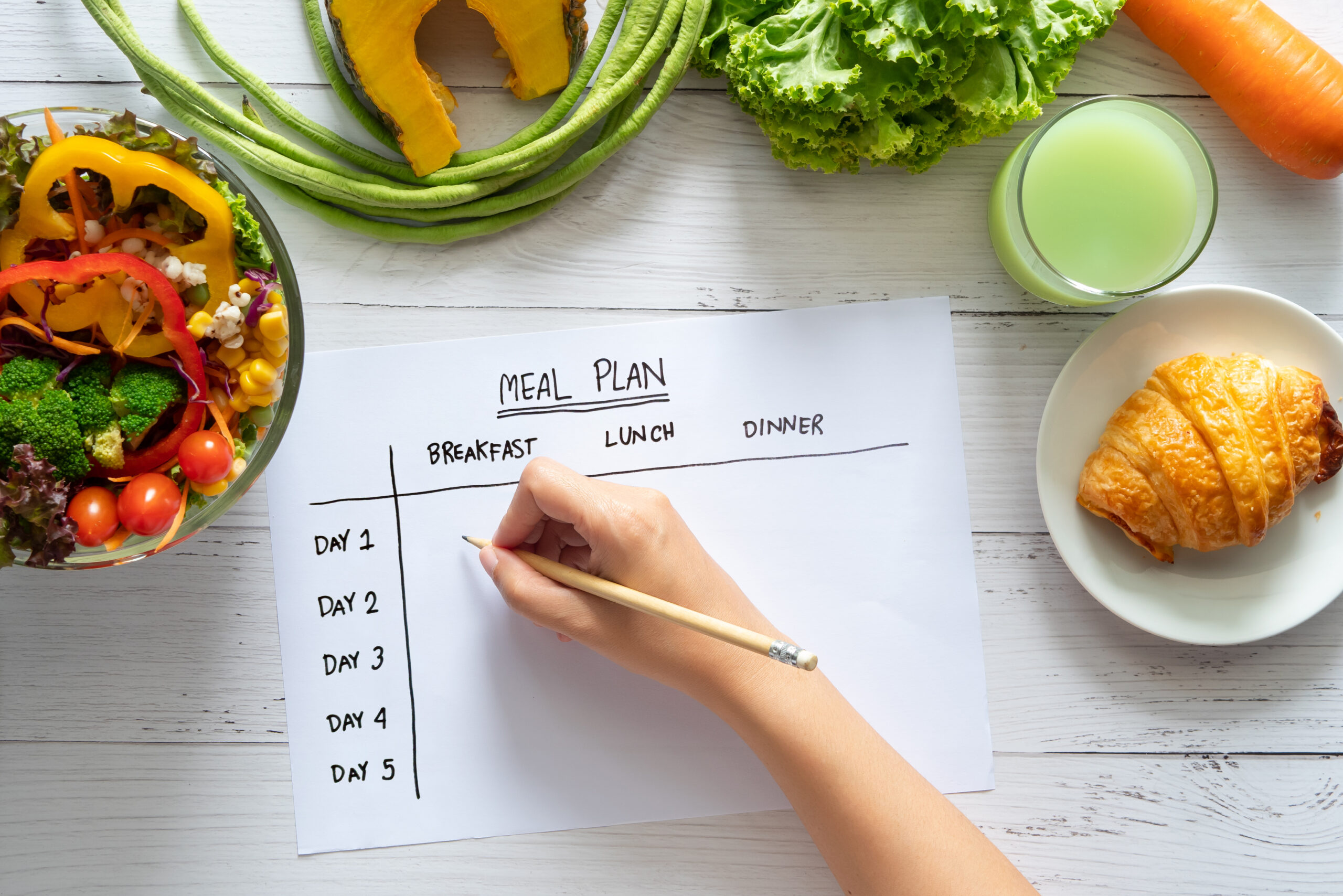
What’s for dinner? One of the most dreaded questions is what everyone eats for every meal, every day. Deciding what everyone eats is EXHAUSTING! One thing that is supposed to help answer that darn question, which is supposed to save you money and save you time, is meal planning. Planning meals for the family can often feel overwhelming, but with a structured approach, it can become an enjoyable and engaging experience or at least a little less painful.
First you want to start by assessing your family’s needs. Consider dietary preferences such as allergies, restrictions, or specific likes, like vegetarian or gluten-free options. Moreover, decide on the meal frequency like how many meals you need to plan for each day, including breakfast, lunch, dinner, and snacks.
Setting clear goals is vital. Focus on health by aiming for balanced meals rich in fruits, vegetables, proteins, and whole grains. Additionally, determine a budget for groceries to guide your meal choices, ensuring that you can provide nutritious meals without overspending. We get it…things are expensive. Try shopping sales, maybe hitting up bargain places like Grocery Outlet, or buy in bulk. Also plan your menu around what’s in season. Go to our local farm stores. This is a great way to shop local and save money!
Gathering inspiration is the next step. Collect your family’s favorite recipes and explore new ones through cookbooks, websites, or apps. We can help, too! Check out Great Oregon Made Healthy Sport Snacks for Kids or Oregon Lunch Box Choose Your Own Adventure – How To Make The Perfect School Lunch For Your Kids. These articles give suggestions for snacks and meals that all have a local flair. We have so many great places to get food in the Pacific Northwest!
By planning ahead, you can incorporate variety into your meals, mixing different proteins, grains, and vegetables throughout the week. And here is one of the biggest protips … farm out your meal planning for AI. Yes, you read that right. You can customize your parameters and have technology do the planning for you. For instance, here is a month’s worth of meals that cover Breakfast, Lunch, Dinner, and Snacks for “kid-friendly” meals. You can specify the prompt that makes sense for your family. Please note that this sample plan does not account for leftovers.
Week 1
Monday
- Breakfast: Scrambled eggs, toast, and orange slices.
- Lunch: Grilled cheese sandwich with carrot sticks and applesauce.
- Dinner: Spaghetti with marinara sauce, meatballs, and garlic bread.
- Snack: Yogurt and granola.
Tuesday
- Breakfast: Pancakes with fresh strawberries and syrup.
- Lunch: Turkey and cheese wrap with cucumber sticks.
- Dinner: Tacos with ground beef, cheese, lettuce, and salsa.
- Snack: Pretzels and a cheese stick.
Wednesday
- Breakfast: Yogurt parfait with berries and honey.
- Lunch: Mini pizza bagels and grapes.
- Dinner: Baked chicken nuggets, mashed potatoes, and steamed broccoli.
- Snack: Apple slices with peanut butter.
Thursday
- Breakfast: Oatmeal with cinnamon and banana slices.
- Lunch: Ham and cheese sandwich with veggie sticks.
- Dinner: Macaroni and cheese with a side of peas.
- Snack: Trail mix (nuts, dried fruit, and pretzels).
Friday
- Breakfast: Smoothie (banana, berries, spinach, and yogurt) with toast.
- Lunch: DIY Lunchables (crackers, cheese, deli meat, and fruit).
- Dinner: Homemade veggie or cheese pizza.
- Snack: Popcorn.
Saturday
- Breakfast: French toast with syrup and blueberries.
- Lunch: Pasta salad with chicken and mixed veggies.
- Dinner: Burgers with sweet potato fries.
- Snack: Fruit kabobs.
Sunday
- Breakfast: Cereal with milk and a side of fresh fruit.
- Lunch: Cheese quesadilla with guacamole and salsa.
- Dinner: Grilled salmon, rice, and green beans.
- Snack: Rice cakes with cream cheese and jam.
Week 2
Monday
- Breakfast: Waffles with peanut butter and sliced bananas.
- Lunch: Chicken salad sandwich with celery sticks.
- Dinner: Beef stir-fry with rice and vegetables.
- Snack: Graham crackers with cream cheese.
Tuesday
- Breakfast: Bagel with cream cheese and a side of grapes.
- Lunch: Ham and cheese pinwheels with cherry tomatoes.
- Dinner: Baked fish sticks with roasted potatoes and green beans.
- Snack: String cheese and apple slices.
Wednesday
- Breakfast: Smoothie bowl with almond butter and granola.
- Lunch: Turkey and cheese sandwich with a side of cucumbers.
- Dinner: Chicken tacos with lettuce, cheese, and mild salsa.
- Snack: Goldfish crackers and baby carrots.
Thursday
- Breakfast: Oatmeal with raisins and maple syrup.
- Lunch: Pasta with butter and Parmesan cheese, with a side of peas.
- Dinner: Meatloaf muffins, mashed potatoes, and steamed carrots.
- Snack: Rice Krispies treats.
Friday
- Breakfast: Scrambled eggs with cheese and toast.
- Lunch: DIY pita pizzas with pepperoni and cheese.
- Dinner: BBQ chicken, corn on the cob, and coleslaw.
- Snack: Frozen yogurt popsicles.
Saturday
- Breakfast: Breakfast burrito with eggs, cheese, and salsa.
- Lunch: Mini sliders with veggie sticks.
- Dinner: Spaghetti with turkey meatballs and garlic knots.
- Snack: Apples with caramel dip.
Sunday
- Breakfast: Cereal and milk with a side of berries.
- Lunch: Cheese quesadilla with salsa and sour cream.
- Dinner: Baked ziti with a green salad.
- Snack: Trail mix.
Week 3
Monday
- Breakfast: English muffin with jam and a side of melon.
- Lunch: Chicken wrap with lettuce and ranch.
- Dinner: Grilled cheese and tomato soup.
- Snack: Animal crackers and yogurt.
Tuesday
- Breakfast: Pancakes with blueberries and syrup.
- Lunch: Pasta salad with turkey and mixed veggies.
- Dinner: Sloppy Joes with baked fries and cucumber slices.
- Snack: Cheese cubes and crackers.
Wednesday
- Breakfast: Yogurt with granola and honey.
- Lunch: Chicken quesadilla with a side of salsa.
- Dinner: Breaded chicken tenders with mashed potatoes and peas.
- Snack: Grapes and pretzels.
Thursday
- Breakfast: Bagel with peanut butter and sliced bananas.
- Lunch: Ham and cheese sandwich with carrot sticks.
- Dinner: Homemade chili with cornbread.
- Snack: Celery with cream cheese.
Friday
- Breakfast: Smoothie (strawberries, banana, and yogurt) with a granola bar.
- Lunch: Turkey pinwheels with cherry tomatoes.
- Dinner: Mini pizzas made with English muffins.
- Snack: Rice cakes with peanut butter.
Saturday
- Breakfast: French toast sticks with a side of strawberries.
- Lunch: Tuna salad sandwich with veggie chips.
- Dinner: Chicken Alfredo pasta with steamed broccoli.
- Snack: Popcorn with a sprinkle of Parmesan.
Sunday
- Breakfast: Cereal with milk and sliced bananas.
- Lunch: DIY nachos with beans, cheese, and mild salsa.
- Dinner: Roasted chicken, mashed sweet potatoes, and green beans.
- Snack: Fruit kabobs with yogurt dip.
Week 4
Monday
- Breakfast: Scrambled eggs with cheese and toast.
- Lunch: Grilled cheese with a side of tomato soup.
- Dinner: Turkey meatballs with spaghetti and garlic bread.
- Snack: Applesauce pouches.
Tuesday
- Breakfast: Muffins with yogurt and a side of fruit.
- Lunch: Ham and cheese wrap with baby carrots.
- Dinner: Chicken stir-fry with rice and vegetables.
- Snack: Graham crackers and milk.
Wednesday
- Breakfast: Pancakes with maple syrup and fresh berries.
- Lunch: Pasta with marinara sauce and a side of cucumbers.
- Dinner: Cheese quesadilla with guacamole and sour cream.
- Snack: String cheese and crackers.
Thursday
- Breakfast: Bagel with cream cheese and jam.
- Lunch: Turkey sandwich with apple slices.
- Dinner: Baked chicken thighs, mashed potatoes, and roasted broccoli.
- Snack: Yogurt with granola.
Friday
- Breakfast: Smoothie bowl with granola and fresh fruit.
- Lunch: DIY lunchables with crackers, cheese, and deli meat.
- Dinner: BBQ pulled chicken sliders with corn on the cob.
- Snack: Veggie chips with ranch dip.
Saturday
- Breakfast: Waffles with peanut butter and sliced bananas.
- Lunch: Mini pizzas made with bagels.
- Dinner: Beef tacos with lettuce, cheese, and salsa.
- Snack: Fruit leather and popcorn.
Sunday
- Breakfast: Oatmeal with raisins and cinnamon.
- Lunch: Tuna salad sandwich with veggie sticks.
- Dinner: Lasagna with garlic bread and a green salad.
- Snack: Frozen yogurt popsicles.
Now is AI menu planning fool proof? Not even close! But it is so helpful for inspiration. Once your menu is set, make a grocery list. List all the ingredients you’ll need based on your planned meals, and check your pantry and refrigerator to avoid buying duplicates. Preparing in batches can save time during the week. Consider chopping vegetables or cooking grains in advance, and don’t hesitate to cook extra portions to freeze for those busy days.
Flexibility is key in meal planning. Be willing to swap meals around based on your family’s schedule or any unexpected events. Establish a feedback loop by asking family members for their input on meals, which can help you adjust future plans accordingly. At the end of each week, take some time to review and reflect. Evaluate what worked well and what didn’t, using this feedback to improve your next meal planning session.
To make the process easier, consider keeping a visual calendar using a whiteboard or an app to track your meal plans. Involve family members in the planning and cooking process to encourage engagement and make it a fun activity.
While meal planning may initially feel like a daunting task (because it is), it is an invaluable tool for reducing stress, saving money, and fostering healthy eating habits. By assessing your family’s needs, setting goals, and leveraging resources like AI meal plans or seasonal shopping, you can transform the “What’s for dinner?” dilemma into a manageable routine. Remember, flexibility and family involvement are key to making meal planning successful and sustainable. With practice and a little creativity, you can streamline this daily challenge and create a system that works for your household.
Tell us about how you meal plan. What works best for you and your family? We would love your tips and tricks!

Johanna is married with two kids, three dogs, three cats, one leopard gecko, several chickens, and a few fish. She has been in the Pacific Northwest since the dream was alive in the 90s but has Southern roots and hails from Arkansas. The family spends a lot of time at some sort of sporting event for the kids. Johanna likes to fast craft, garden, host parties, and bake. Johanna and her crew go hard traveling, DIY-ing, and are always up for a new adventure or challenge.
